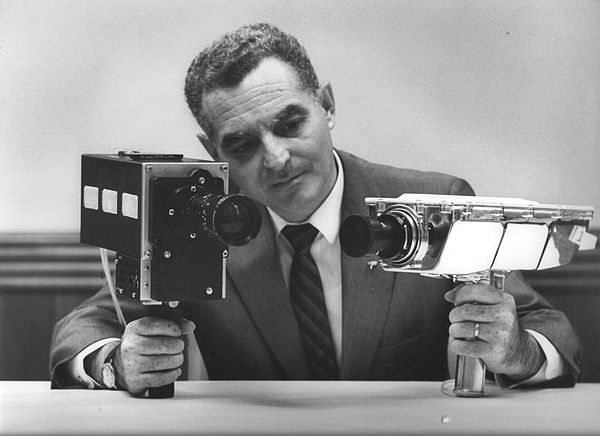Portal:Television
The Television Portal

Television (TV) is a telecommunication medium for transmitting moving images and sound. Additionally, the term can refer to a physical television set rather than the medium of transmission. Television is a mass medium for advertising, entertainment, news, and sports. The medium is capable of more than "radio broadcasting," which refers to an audio signal sent to radio receivers.
Television became available in crude experimental forms in the 1920s, but only after several years of further development was the new technology marketed to consumers. After World War II, an improved form of black-and-white television broadcasting became popular in the United Kingdom and the United States, and television sets became commonplace in homes, businesses, and institutions. During the 1950s, television was the primary medium for influencing public opinion. In the mid-1960s, color broadcasting was introduced in the U.S. and most other developed countries.
In 2013, 79% of the world's households owned a television set. The replacement of earlier cathode-ray tube (CRT) screen displays with compact, energy-efficient, flat-panel alternative technologies such as LCDs (both fluorescent-backlit and LED), OLED displays, and plasma displays was a hardware revolution that began with computer monitors in the late 1990s. Most television sets sold in the 2000s were still CRT, it was only in early 2010s that flat-screen TVs decisively overtook CRT. Major manufacturers announced the discontinuation of CRT, Digital Light Processing (DLP), plasma, and even fluorescent-backlit LCDs by the mid-2010s. LEDs are being gradually replaced by OLEDs. Also, major manufacturers have started increasingly producing smart TVs in the mid-2010s. Smart TVs with integrated Internet and Web 2.0 functions became the dominant form of television by the late 2010s.[better source needed] (Full article...)
Selected article -
Selected image -

The Apollo TV camera refers to several television cameras used in the Apollo program's space missions, and on the later Skylab and Apollo-Soyuz Test Project missions, in the late 1960s and 1970s. These cameras varied in design, with image quality improving significantly with each successive model. Two companies made these various camera systems: RCA and Westinghouse. Originally, these slow-scan television (SSTV) cameras, running at 10 frames-per-second (fps), produced only black-and-white pictures and first flew on the Apollo 7 mission in October 1968. A color camera — using a field-sequential color system — flew on the Apollo 10 mission in May 1969, and every mission after that. The Color Camera ran at the North American standard 30 fps. The cameras all used image pickup tubes that were initially fragile, as one was irreparably damaged during the live broadcast of the Apollo 12 mission's first moonwalk. Starting with the Apollo 15 mission, a more robust, damage-resistant camera was used on the lunar surface. All of these cameras required signal processing back on Earth to make the frame rate and color encoding compatible with analog broadcast television standards.
Did you know (auto-generated) -

- ... that the 1999 television film Down Will Come Baby aired two weeks after the Columbine High School massacre and was criticized for exploiting parental fears with its depiction of child violence?
- ... that due to her leftist beliefs, journalist Ana Amado was told not to come to work by her public television employer while her husband was on the death list of the Argentine Anticommunist Alliance?
- ... that Donald A. Morgan is the first director of photography to be inducted into the Television Hall of Fame?
- ... that Svalbard Minute by Minute, a 221-hour-long television broadcast, is credited with increasing tourism in Svalbard by 25 percent?
- ... that to prepare for her role in the television film Search for Grace, actress Lisa Hartman Black underwent hypnosis?
- ... that ethnic broadcasting pioneer Shushma Datt was the first Canadian woman to obtain a CRTC broadcast licence?
Selected quote -
More did you know
- ...that The Simpsons and Philosophy: The D'oh! of Homer, a book that analyzes the The Simpsons using philosophical concepts, is the main textbook in philosophy courses offered at some universities?
- ...that Anne Montgomery, who has been a sportscaster for several local television stations as well as SportsCenter, was the first female football referee in Arizona?
- ...that the ABC television network created controversy when they licensed and produced a doll based on fictional rapist Todd Manning?
- ...that Melbourne rock band The Strangers appeared on weekly television for nine years straight?
- ...that like the characters in his television series The Practice and Boston Legal, David E. Kelley worked as a lawyer in a Boston law firm?
Selected biography -
Howard W. "Kroger" Babb (December 30, 1906 – January 28, 1980) was an American film producer and showman. His marketing techniques were similar to a travelling salesman's, with roots in the medicine show tradition. Self-described as "America's Fearless Young Showman", he is best known for his presentation of the 1945 exploitation film Mom and Dad, which was added to the National Film Registry of the Library of Congress in 2005.
Babb was involved in the production and marketing of many films and television shows, promoting each according to his favorite marketing motto: "You gotta tell 'em to sell 'em." His films ranged from sex education-style dramas to "documentaries" on foreign cultures, intended to titillate audiences rather than to educate them, maximizing profits via marketing gimmicks. (Full article...)
General images
News
- December 28: US professional wrestler Jon Huber dies aged 41
- September 2: Tributes paid to recently deceased US actor Chadwick Boseman
- May 24: Japanese professional wrestler and Netflix star Hana Kimura dies aged 22
- January 16: BBC newsreader Alagiah to undergo treatment for bowel cancer
- Upcoming events
Featured content
Main topics
History of television: Early television stations • Geographical usage of television • Golden Age of Television • List of experimental television stations • List of years in television • Mechanical television • Social aspects of television • Television systems before 1940 • Timeline of the introduction of television in countries • Timeline of the introduction of color television in countries
Inventors and pioneers: John Logie Baird • Alan Blumlein • Walter Bruch • Alan Archibald Campbell-Swinton • Allen B. DuMont • Philo Taylor Farnsworth • Charles Francis Jenkins • Boris Grabovsky • Paul Gottlieb Nipkow • Constantin Perskyi • Boris Rosing • David Sarnoff • Kálmán Tihanyi • Vladimir Zworykin
Technology: Comparison of display technology • Digital television • Liquid crystal display television • Large-screen television technology • Technology of television
Terms: Broadcast television systems • Composite monitor • HDTV • Liquid crystal display television • PAL • Picture-in-picture • Pay-per-view • Plasma display • NICAM • NTSC • SECAM
Categories
WikiProjects

|
You are invited to participate in WikiProject Television, a WikiProject dedicated to developing and improving articles about Television. |
- Main projects
- Sub-projects
Television Stations • American animation • American television • Australian television • British TV • BBC • Canadian TV shows • Television Game Shows • ITC Entertainment Productions • Digimon • Buffyverse • Doctor Who • Degrassi • EastEnders • Episode coverage • Firefly • Futurama • Grey's Anatomy • Indian television • Lost • Nickelodeon • The O.C. • Professional Wrestling • Reality TV • The Simpsons • Seinfeld • South Park • Stargate • Star Trek • Star Wars • Soap operas • Avatar: The Last Airbender • House
- Related projects
Animation • Anime and manga • Comedy • Comics • Fictional characters • Film • Media franchises
What are WikiProjects?
Things you can do

- Place the {{WikiProject Television}} project banner on the talk pages of all articles within the scope of the project.
- Write: Possible Possum
- Cleanup: color television, Alien Nation: Body and Soul, The Sopranos, Alien Nation: Dark Horizon, Alien Nation: The Enemy Within, Alien Nation: Millennium, Aang
- Expand: Timeline of the introduction of color television in countries
- Stubs: Flow (television), Just for Kicks (TV series), Play of the Month, Nova (Dutch TV series), More stubs...
Subportals
Related portals
Associated Wikimedia
The following Wikimedia Foundation sister projects provide more on this subject:
-
Commons
Free media repository -
Wikibooks
Free textbooks and manuals -
Wikidata
Free knowledge base -
Wikinews
Free-content news -
Wikiquote
Collection of quotations -
Wikisource
Free-content library -
Wikiversity
Free learning tools -
Wiktionary
Dictionary and thesaurus


























![Image 1 Video blogger Alex Day performing during the ninth episode of Chartjackers. The British documentary series Chartjackers ran for a single season of eleven weekly episodes during the autumn of 2009. The series documents the lives of four teenage video bloggers—Alex Day, Johnny Haggart, Jimmy Hill, and Charlotte McDonnell (formerly Charlie McDonnell)—from the video-sharing website YouTube as they attempt to write, record and release a pop song by crowdsourcing through social media in ten weeks. When initially aired, the first ten episodes of Chartjackers, each five minutes in length, detailed the events of the previous seven days. The final episode, broadcast on 21 November 2009, compiled highlights from the previous ten weeks into one 30-minute episode, which was narrated by British DJ MistaJam. All eleven episodes were produced by Adam King and Jonathan Davenport of the production company Hat Trick Productions. Chartjackers was devised in 2009 by Davenport and Andy Mettam of Hat Trick Productions, and was commissioned for development by Geoffrey Goodwin and Jo Twist of BBC Switch. Alongside the programmes Off the Hook and The Cut, it was featured as part of a season of multi-platform content designed to appeal to teenagers. The show was also directly linked to the 2009 annual appeal for the British charity Children in Need – profits from sales of the completed pop song were donated to the charity. Chartjackers aired weekly at approximately 1:10 p.m. on Saturday afternoons on BBC Two, with the first episode premiering on 12 September 2009 during the channel's two-hour long BBC Switch segment. The series garnered a viewing figures peak of almost half a million with its final episode and was critically panned by reviewers. Each episode was streamed online through BBC iPlayer to UK residents for seven days after its initial airing. The series was not broadcast outside the UK and, as of 14 December 2011[update], is not available to buy on DVD. (Full article...)](http://upload.wikimedia.org/wikipedia/en/d/d2/Blank.png)






































